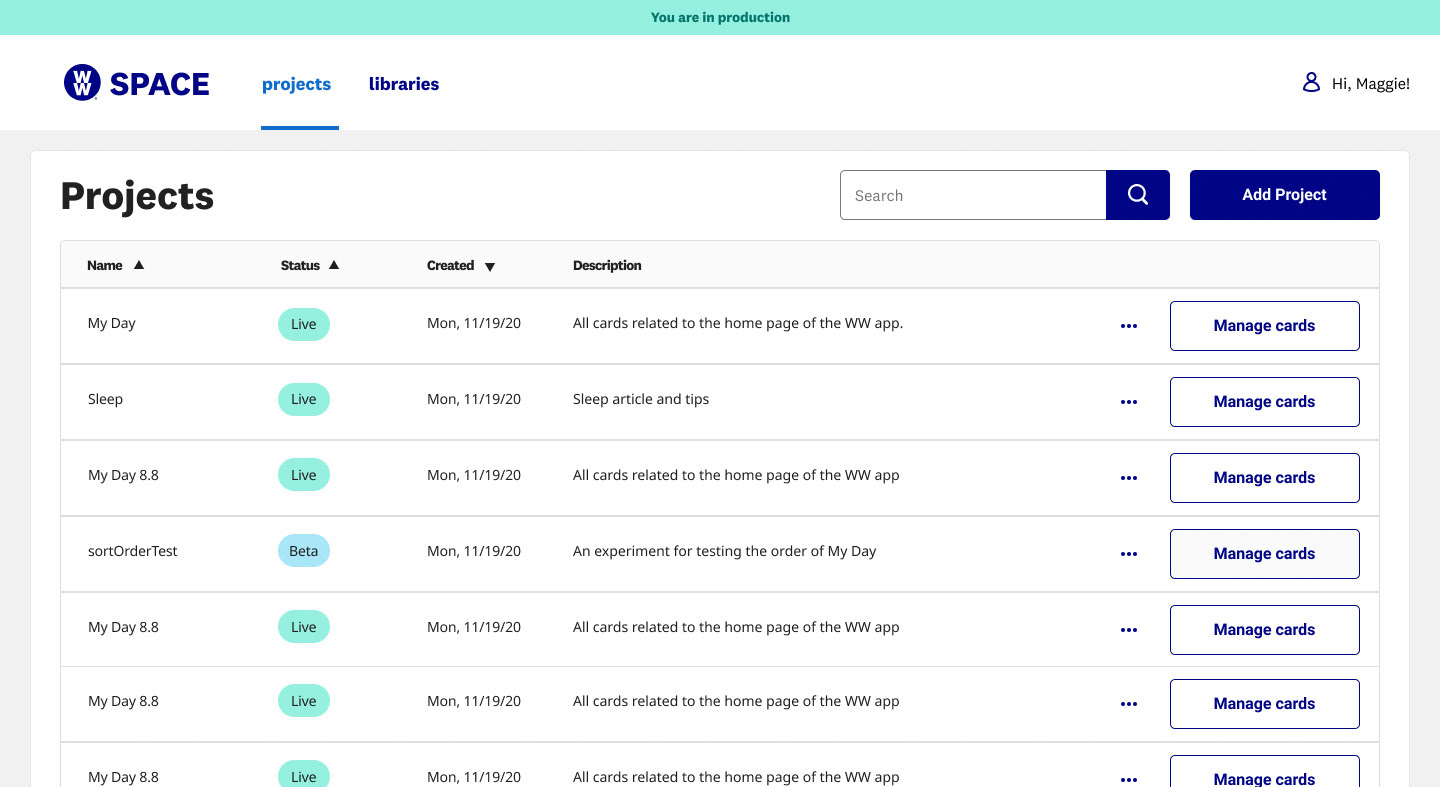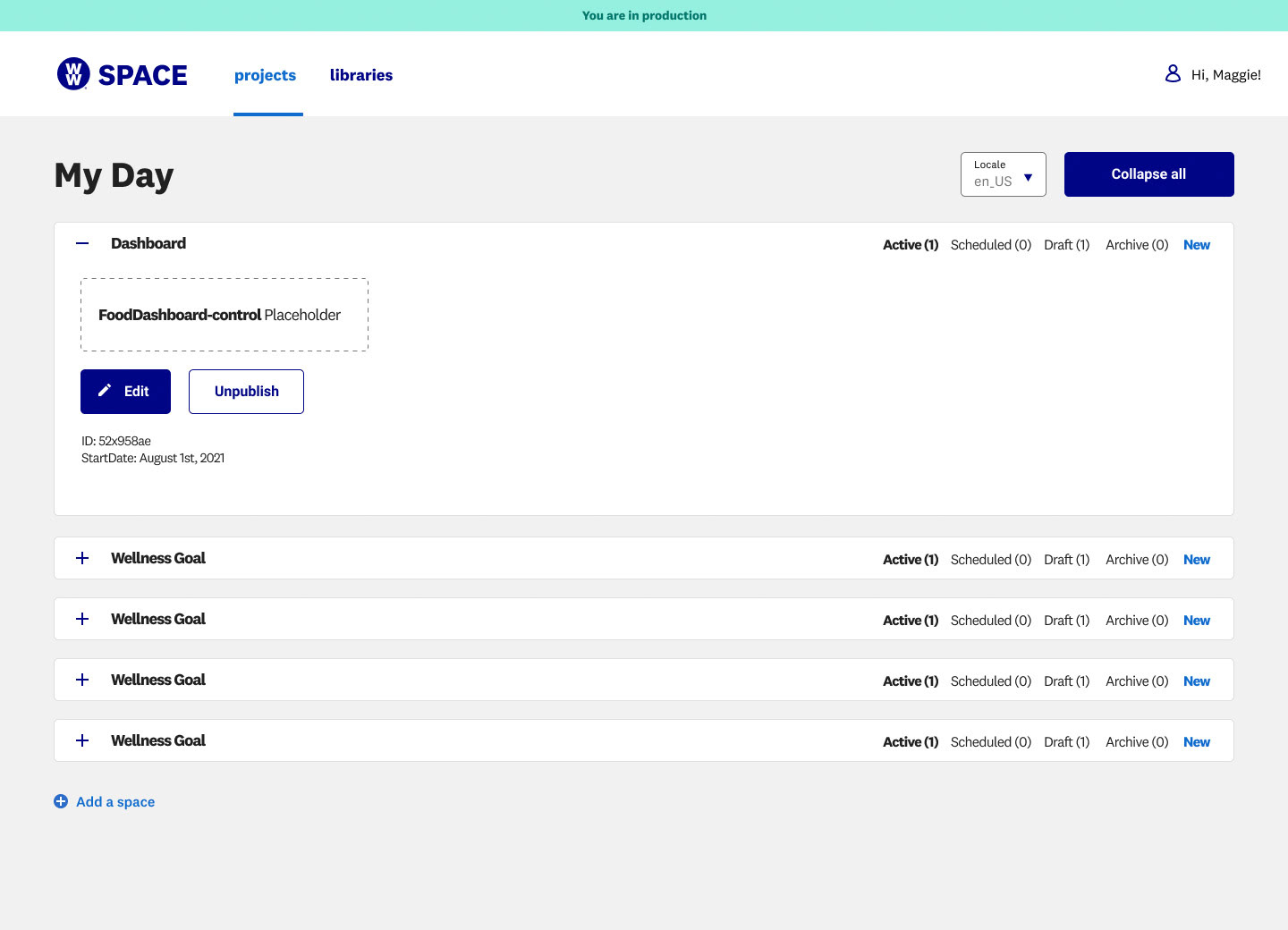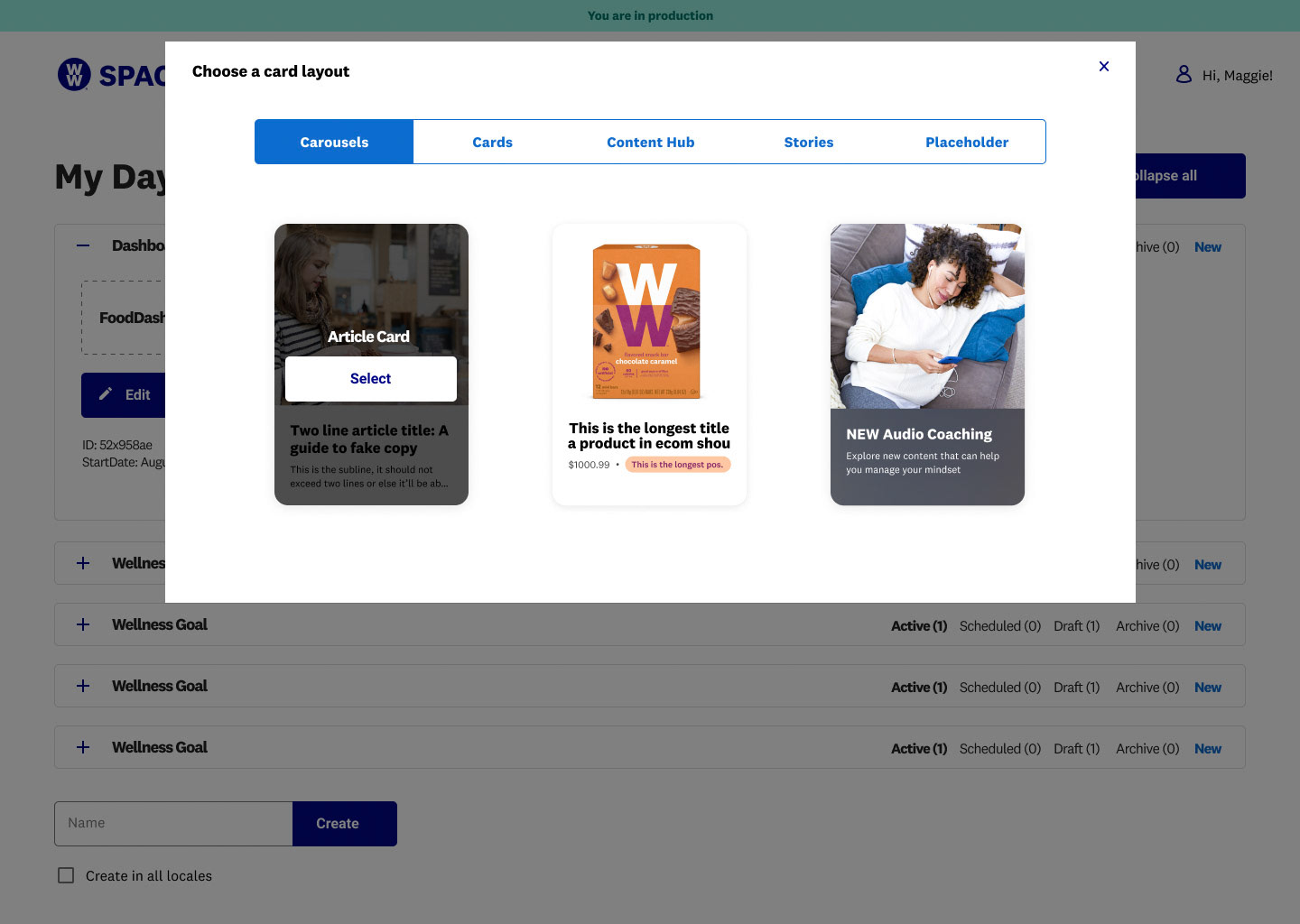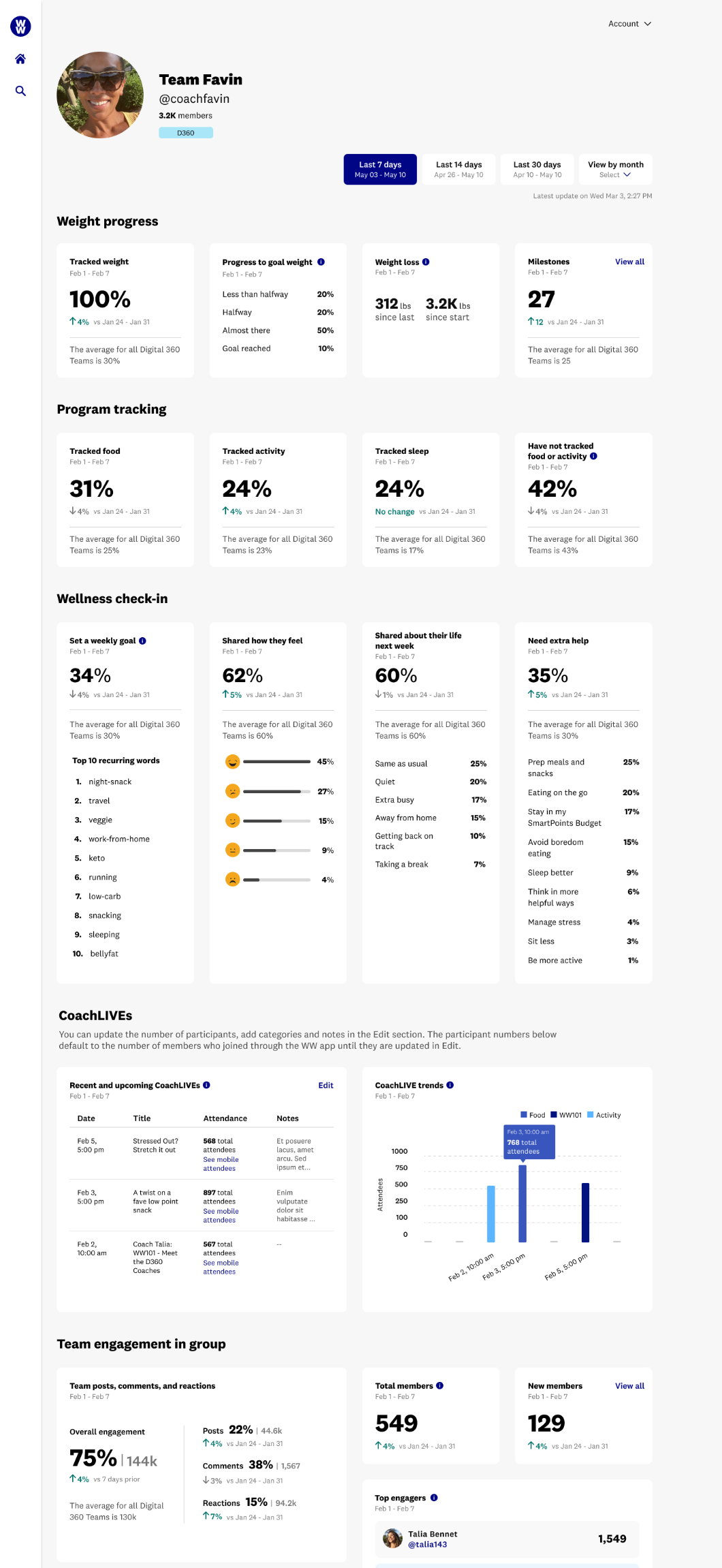My Role
I joined WW in January of 2020 as a Sr. Product Design Manager for the Community, Coaching, and Content (CCC) team at WW. Together with product & tech leadership, we were responsible for envisioning and leading the execution of a new premium membership tier that would deliver supportive coaching & community-based accountability, motivation, & guidance to our digital members. I was responsible for leading the end-to-end Product Design effort for this initiative.
The Team
I worked across multiple cross-disciplinary teams (inclusive of product, tech, marketing, business development, science, coach talent, content, etc...) to deliver every facet of this new digital coach-led experience by the end of the year; from the in-app member experience, to the back-office coaching experience, to the content editing (CMS) experience. I managed a team of 2-5 product designers during the course of the project.
__________________________________
Problem Definition
The Problem
WW's brand has always been synonymous with coach-led guidance, community, and sustainable weight loss. The WW app was originally built as a companion app for in-person studios as a means to easily track food. However, the digital-only membership grew to surpass the studio membership (accounting for ~70% of sign-ups by Jan 2020). The primary services of accountability, motivation & guidance that coaches provided via the studio rapidly became an unmet need for WW's digital-only member base.
The need for a digital-only coaching solution became even more critical for the business when the COVID-19 pandemic accelerated this shift.
Our Member Journey
Our Member Journey relies on supportive guidance to help members with "the hard part" to keep them engaged and stick with the program.
Correlated Evidence
Members who are lonely or isolated lose less weight.
Members who refer friends or are referred, engage on Connect (our social network), report having meaningful interactions, belonging, and responsiveness within the WW ecosystem lose more weight.
Greater similarity to other members leads to more engagement.
Engagement Evidence
Data suggests that the vast majority of members are in the "struggling with challenges" bucket, or are in danger of lapsing.
Our New Target Member: Zoe
Zoe is a millenial with more weight to lose (and more weight loss attempts) than the average digital member. She's active on social media, super busy, and digitally savvy. She's looking for a weight loss solution that is flexible and fits into her busy lifestyle. She's also never tried WW before.
She needs more accountability, guidance, and support than a digital member in order to help her be successful, but it has to be on her terms.
Zoe & Accountability
There are three types of Accountability: Zoe indexes higher on needing accountability from another person, and from social groups, because she struggles to hold herself accountable.
The Business Directive
Our 2020 priority was to launch a brand new middle-tier membership offering that delivers supportive coaching for a 30-something, digitally savvy, always "on-the-go," net-new member (Zoe.)
__________________________________
Strategy Phase
Launching this membership involved coordination with every team across WW's vast organization (Product, Tech, Design, XR, Human Truths, Analytics, Marketing, Science, Coaching, Service Design, Content & Event Ops, Business Development, Brand, etc...). We started by partnering closely with these different teams to clarify the strategy and understand the program objectives for this new membership offering.
Coaching Strategy
The way Zoe would interact with and access WW's Digital 360 coaches was clarified as part of our Coaching Strategy. The relationship between coaches and Digital 360 members would be a para-social one (meaning the relationship is one-way but the content is meaningful / relatable to Zoe). This allowed WW to deliver premium coaching at a scale that would be viable for the business (in the 1:100,000's).
Content Strategy
The content strategy was centered around the idea of "always on" coach-led content via daily inspirational social media styled posts by coaches, live experiences (such as cooking classes), on-demand video, and podcasts. All of this would be accessible via the app, whenever Zoe needed it.
Product Strategy
The product strategy centered around ways in which the product could deliver the accountability that Zoe needs within a 1:many coaching model, along with community-based accountability.
Timeline
WW's business is seasonal, so a target launch date was set for January 2021 (diet season) and a beta target for November 2020. By now, it was mid-July.
__________________________________
Design Sprint
Planning Phase
By the time we'd received and digested all the discovery information and the timeline, we had to move fast. In collaboration with cross-functional partners, it was my job to lead my team in applying the the Design Thinking process to what we had learned in order to come up with an MVP experience that could be designed and built within 3 months.
We quickly pulled together a plan for a 1.5 week-long design sprint to generate a concept design for a Digital 360 coaching destination that could be quickly tested and iterated upon.
Constraints
Because of our timeline, we had a number of constraints. Primarily, this experience would be built on our Connect social networking platform, with no customization to existing components.
Our Hypothesis Statement:
Because we know that Zoe needs more accountability, guidance, and support from another person and social groups, then we believe that offering her a destination where she can find daily inspiration & informative content from coaches, access to virtual live events, and a coach-led supportive community will result in increased weight loss, program success, and satisfaction with her premium membership.
Day 1: Understanding the Challenge
We spent a day immersed in the research that had been done to date to get a deep understanding of the problem space and considerations for what we needed to design. Our design sprint was based on five research inputs:
Stakeholder Interviews
Parallel with the planning, we put together an interview form and sent it to every executive to get their perspective as a way to ensure the team and leadership were aligned.
MaxDiff Study:
What types of coach content yields the greatest group engagement and value to members?
Daily Posts on living the program indexed the highest in terms of value, followed by live discussions & monthly challenges.
Coach Bios XR Study
Understanding the contributing factors that members consider when choosing a coach.
Above all else, members look for coaches that are relatable to them: Specifically, are similar in lifestyle (has kids, etc...) and a similar transformation or weight loss journey.
Key Drivers of Member Success
A study around what types of behaviors help and/or hurt members ability to be successful.
IRL barriers are our biggest hurdle to help Zoe overcome. It was critical to give her the emotional and social support she needs through our coaches and community, as well as guidance on how to combat those barriers.
__________________________________
Days 2-3: HMWs & Ideation
We brainstormed HMWs that would help to focus and inspire our ideation. Crazy 8's, building on the ideas of others, and solution sketches were the final outcome of this workshop.
Lightning Demos
To get the creative juices flowing, we each shared other apps and websites that inspired us, and explored how they integrate coaching & community in a way that feels guided and builds accountability.
Some of our chief sources of inspiration were Nike Training Club, Peloton, Masterclass, and Instagram.
Top Voted HMW's
HMW encourage engagement and adoption of coach-led behaviors within the context of a supportive community?
HMW structure content in the coach hub to avoid overwhelming members?
HMW make attending live experiences easy and enticing?
HMW help members choose a coach they can relate to?
Crazy 8's & Solution Sketching
We did Crazy 8's, and then solution sketched our favorite ideas in slightly higher fidelity.
The team did a dot voting exercise, and decision makers met separately to deliberate over the sketches. We selected the ideas (or parts of ideas) that resonated best with our strategy and communicated those ideas back to the team.
__________________________________
Days 4-5: Wireframe & Prototype
My team took the sketches from the ideation and began laying out rough wireframe flows.
Ideas were based off the hypothesis that there were two ways to engage with content. The first was a discovery tab that included all coach content, posts, and videos (visible to all, regardless if you've followed a coach). The second was a "My Coaches" tab that would show members just the content for the coaches they were following. Members could tap into a coach's profile to learn more about them and choose to follow them. Following would show a "commitment device" screen, a behavioral science solution strategy to encourage follow through on your commitment to engage with your coach and their content.
There were two states to consider: members who have NOT followed any coaches [yet], and members who have.
After consulting with our engineering team, we learned that it was not going to be technically feasible to have a "two-tabbed" approach on the Coach Hub based on our platform limitations and timeline. We then explored how we might encourage the selection and exploration of coaches & their content on a single page.
We did a quick visual pass and put together a simple prototype to test.
__________________________________
We tested with seven "Zoes". The goal of our testing was to understand their perception of the different features and flows within the design sprint concept. We wanted to understand their expectations when it came to delivering on premium coaching, content, and community.
Key Insights
+ People want to know what to expect, and the value they will get.
+ At different points in the journey people can be in different modes: onboarding mode, exploring mode, catching up/right now mode, and planning mode.
+ People expect different flavors from different coaches (e.g., their unique personalities, strengths, and approaches).
+ Accountability (from others) was feeling thin for some.
+ At different points in the journey people can be in different modes: onboarding mode, exploring mode, catching up/right now mode, and planning mode.
+ People expect different flavors from different coaches (e.g., their unique personalities, strengths, and approaches).
+ Accountability (from others) was feeling thin for some.
On Following Coaches
"Meet Your Coaches" suggests the coaches were already chosen for them (no CTA to choose). They didn't understand that following was the primary behavior we were hoping to drive with this design.
Confusing affordance, unclear value, and a lack of clarity about who they were following were the primary problems to solve.
On live events
The upcoming live events fit their "planning" modality. But many wanted to know, "What can I do right now?"
They expected to be notified and be able to add the event to their calendar.
This drew comparisons with Facebook / Instagram LIVE in terms of what they expected to get out of the event.
On Coach's Playbook (Posts)
Participants liked the freedom to explore and see what was being posted. All found the posts to be motivating and encouraging.
"Playbook" language didn't match the content in some cases, and drew unhelpful comparisons with sports.
Post Sprint Explorations
Based on this feedback, the team began to explore ways to drive more adoption of the behaviors we desired. Namely, getting members to follow coaches.
We shifted the landing page focus to be about selecting at least one coach to follow. Upon doing so, the page updated to display the coach's content.
__________________________________
Implementation
While overseeing the implementation of user feedback to the Coach Hub designs, I also worked with the team to explore how this membership should play out across our app. There was not a holistic view of how all the different teams across the organization were contributing to the member experience. This led to confusion and concern that something was going to get missed.
Digital 360 Storyboard & Service Design Blueprint
I led the creation of a comprehensive storyboard, outlining not only Zoe's experience with Digital 360 across our omnichannel ecosystem, but every team's roles & responsibility in making that vision a reality. This required a massive coordination effort with Product, Tech, Content Ops, Community Managers, Event Ops, Content & Media Production, Marketing, and Digital 360 Coaches.
This helped us to plan what areas inside and outside of the app we needed to address, identify gaps in the UX, communicate the full "blueprint" of Zoe's experience, and prioritize our post-launch roadmap.
Final MVP Designs for Coach Hub
The MVP designs were strongly dependent on a member following a coach before they could access coach content. Once they followed at least one coach, their default experience updated to show the "following" experience, where they could see on-demand videos, upcoming CoachLIVE's, and daily posts from the coaches they followed.
Our hypothesis was that if we could get them to focus on JUST the task of selecting a coach, they would be more likely to follow at least one and have a more tailored experience based on their preferences.
Other Design Workstreams for Digital 360
While managing the Coach Hub designs, I also led design efforts to clarify the vision and strategy, communicate the scope, and identify customer needs for the Digital 360 launch across other teams and workstreams as defined across the member journey map.
My Day (App Homepage)
Working with My Day's product managers, Designers, & engineers, we customized content on the app homepage to be relevant for Digital 360 members.
We displayed premium content cards with branded identifiers, Digital 360 coach marks, updated the daily checklist to be coach-led, and exposed upcoming Digital 360 events.
Discover
We also launched a new area in our app called "Discover" that served as the home for all the content the Digital 360 team was creating. Unlike Coach Hub, this was accessible to all members and also included free content.
We had not previously served up content in this way. All the infrastructure had to be created for tagging & searching our content across many different databases, as well as a CMS that allowed us to push content updates without needing an app release (see SPACE below).
Connect
Connect is WW's in app social network where all members go to find peer-to-peer support and accountability.
We hypothesized that because all members are already going to Connect to find community, then giving Digital 360 members an entry point to find their coach-led communities (or "teams") via Connect would result in increased community engagement with those teams.
Our hypothesis was correct, upon launch, we learned that the vast majority of members navigated to coach team pages via Connect. Subsequent research would uncover that member mental models place all social network & community related content (including coach-led communities) in a single destination.






SPACE (CMS)
I oversaw the design of the internal CMS tooling (SPACE) that powered all the content being created and displayed in our app. Working with my team, we grew the tool from powering just a single card on My Day in early 2020 to powering all the content in the app by the end of the year.
This tool gave editors the ability to upload, store, and organize all our content (videos, audio files, etc...) as well as WYSIWYG content editing for carousels and cards in our app, all without requiring an app release.


Coach Portal
The other side of Digital 360 was the Coaches workstream. My team was responsible for delivering tools that would allow them to guide members more effectively.
We created comprehensive dashboard views to empower our coaches with data, so that they could measure the health of their team, see how much weight their group was losing, who was struggling, who was new, who was successful, etc...
This was also helped our community managers to access information about what posts and content were getting the most engagement from members. They could use this to inform their roadmaps and what types of content the coaches should produce to get the best results.
__________________________________
Pilot Launch & Learnings
We successfully launched our new membership pilot in Nov. 2020 to a closed beta audience. The XR, CX, and analytics teams began to quickly gather learnings on how it was performing. The results were challenging...
NPS varied based on behavior
For members that followed coaches, engaged with their content, and watched CoachLIVEs, Digital 360 NPS was significantly higher than for digital-only (~70 vs. ~45).
For members who followed a coach, but did not engage with their content, Digital 360 NPS was lower than digital-only (~24 vs. ~45).
Members who did NOT follow any coaches had the lowest NPS compared to digital-only (~17 vs. ~45).
Conversion Funnel Challenges
According to our conversion funnel, out of those Digital 360 members that entered the app, only 46% were following at least one coach within their first four weeks.
We would later learn that if they didn't follow a coach within the first 28 days of tenure, they were significantly less likely to ever follow one at all.
Barriers to Entry
The top three reasons members did not follow a coach in their first four weeks:
#1. Not ready for "coaching" yet... busy trying to understand the food program.
#2. Not clear on the value of the coach, and mismatched expectations on how they will help.
#3. Discoverability & friction issues associated with following a coach.
New Insights
Addressing the first two barriers would be the teams priority for the majority of 2021... But the third barrier implied that UX issues were a contributing factor to members not following coaches. There was low-hanging fruit the team could address quickly in early Q1, 2021.
Our new hypothesis statement:
"Because we know that members are not following coaches due to a multi-step selection process that only allows for selecting one coach at a time, then we believe that simplifying the coach selection process & encouraging multi-select will result in more members following coaches."
Our new opportunity statement:
"HMW showcase the coach value and encourage members to follow more than one coach in a single step?"
__________________________________
January 2021 Launch
Coach Hub Updates
For official launch, we completely revamped our no following landing page by adding quick "follow" buttons to each Coach's card (with ability to customize the feed from that page after a follow button was tapped). We allowed members to view coach intros without having to leave the page. We added a short "Coach Hub intro" flow for first time visitors, gave access to CoachLIVE events, and re-named the "Choose your Coaches" CTA to "Customize your Coach feed."
These updates led to a follow rate of +64% within their first 7 days of tenure.
NOTE: A/B tests further explored showing or hiding the On-Demand video carousel on this page. Hiding the carousel resulted in a further increase in following coaches.
Fast Follows to encourage more CoachLIVE Attendance
Because CoachLIVES yield high NPS and satisfaction, we improved experiences targeted at getting members to join CoachLIVEs more easily.
We implemented "Add to Calendar" functionality, more reliable push notifications, native event pages with deep linking functionality (for targeted marketing campaigns), redesigned our on-demand cards to display metadata descriptions (CoachLIVE, Quick Tip, WW101, etc...), and displayed upcoming CoachLIVE details on My Day.
Digital 360 Outcomes
Engaged Digital 360 members love the product, and report a high NPS vs. digital-only (~70 vs. ~45), and increased satisfaction (84% vs. 64%).
Digital 360 draws higher return visits to the WW app than digital-only (72% vs. 62%). Compared to digital-only members, Digital 360 members are twice as likely to engage with the WW Community, more likely to weigh-in weekly, and are losing 20% more weight than workshop members.
Digital 360 was also awarded "Best for Building Habits" in Good Housekeeping's 2022 Fitness Awards!